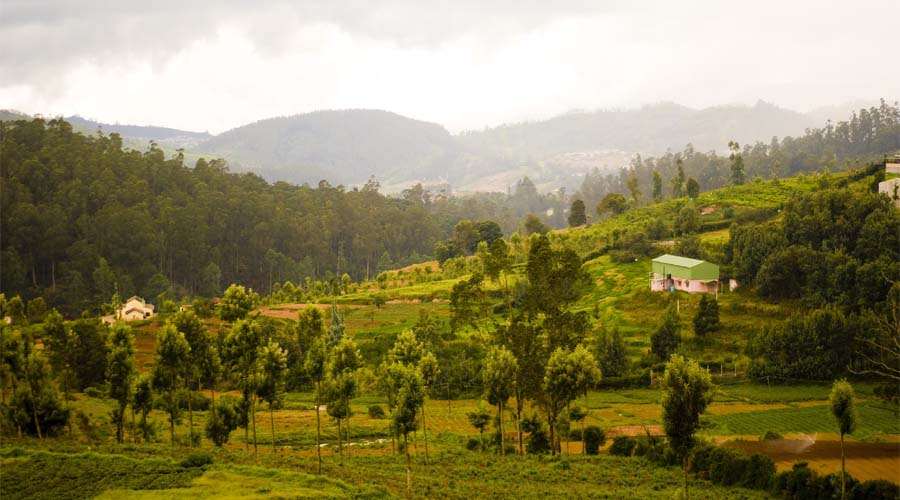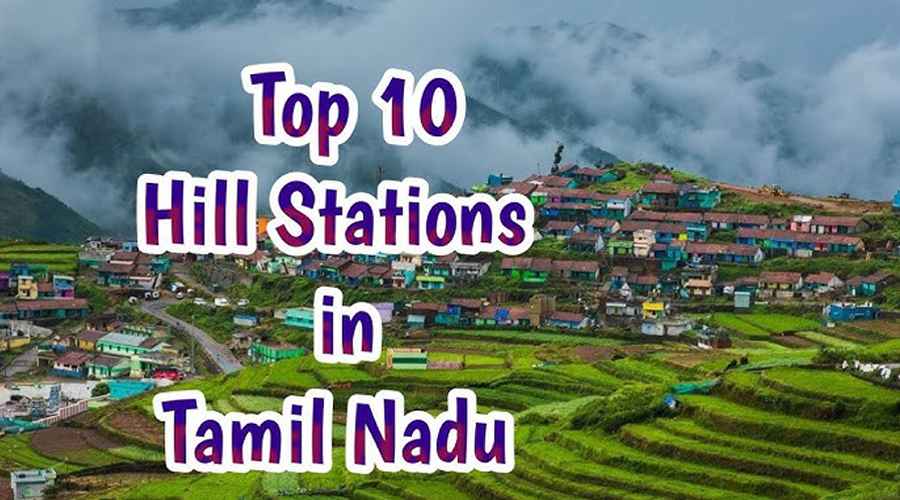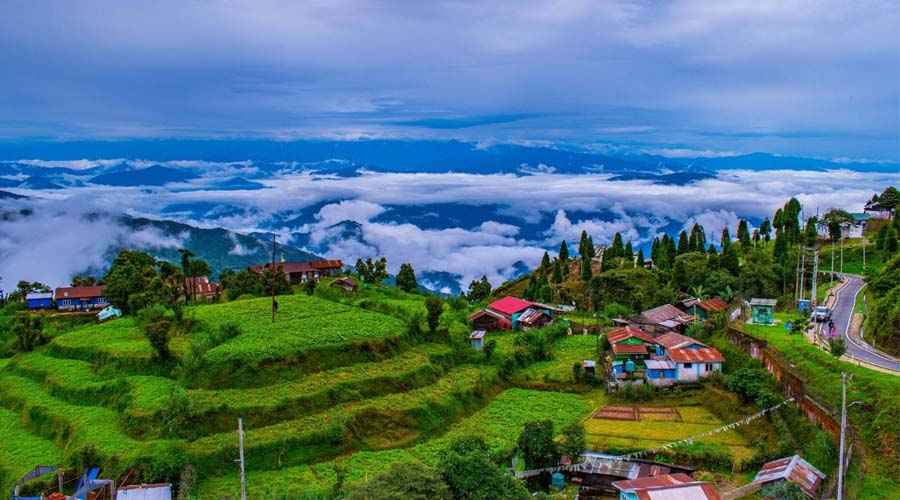Tucked away in the northwestern corner of Tamil Nadu, where the borders of Karnataka and Kerala meet, the Nilgiri Hills stand as one of Southern India’s most enchanting landscapes. Known as the “Blue Mountains” for the bluish haze that envelops them—a phenomenon attributed to the abundant Eucalyptus trees—these hills are a visual and cultural treasure. Rich biodiversity, colonial history, and indigenous heritage converge here, offering travelers a rare combination of natural beauty and cultural immersion.
Geographical Overview
Part of the Western Ghats mountain range, the Nilgiri Hills rise at the tri-junction of three states: Tamil Nadu, Kerala, and Karnataka. The highest peak is Doddabetta, reaching an impressive 2,637 meters above sea level. The region is dotted with rolling tea plantations, dense shola forests, sparkling streams, and charming hill stations that have drawn visitors since the British colonial period.
The Nilgiris are home to a number of rivers, including tributaries of the Bhavani, Moyar, and Kabini, which nourish the surrounding valleys. Their complex geography has also earned them recognition as a UNESCO World Heritage Site under the Western Ghats designation.
Historical and Cultural Significance
Long before the arrival of British settlers in the 19th century, the Nilgiri Hills were inhabited by indigenous tribes such as the Toda, Kota, Kurumba, and Irula communities. These tribes have preserved unique customs, rituals, and lifestyles, including the Toda’s distinctive barrel-shaped huts and pastoral economy. Their presence adds an ancient depth to the region’s identity.
In the early 1800s, the British discovered the Nilgiris as a sanatorium location, drawn by its cool climate, reminiscent of England. Hill stations like Ooty (Udhagamandalam) and Coonoor were developed, complete with colonial architecture, botanical gardens, and railway lines. The establishment of tea plantations followed, transforming the economic and cultural landscape.
The ‘Blue Mountains’ Phenomenon
The romantic moniker “Blue Mountains” comes from the atmospheric scattering of light combined with the aromatic oils released by Eucalyptus trees. The oil particles refract sunlight in such a way that the hills appear draped in a bluish mist, especially at sunrise and sunset. This rare optical charm distinguishes the Nilgiris from other hill ranges in India.
Famous Hill Stations and Attractions
Ooty – The Queen of Hill Stations
Ooty is the crown jewel of the Nilgiris. Known for its lush gardens, serene lakes, and sprawling tea estates, it offers both leisure and adventure. The Government Botanical Garden houses exotic flora, while Ooty Lake is a popular boating spot. Visitors can enjoy panoramic views from Doddabetta Peak, the highest point in the Nilgiris.
Coonoor – Tranquility Among the Tea Fields
Located about 21 km from Ooty, Coonoor is quieter, making it ideal for travelers seeking peace and solitude. Attractions include Sim’s Park, a unique botanical garden, and viewpoints like Dolphin’s Nose, which overlooks breathtaking Catherine Falls.
Kotagiri – The Oldest Hill Station
Smaller and less commercialized, Kotagiri boasts pleasant weather year-round. It is surrounded by trekking trails leading to Kodananad View Point and serene tea plantations.
The Nilgiri Mountain Railway
A UNESCO World Heritage Site, this narrow-gauge railway connects Mettupalayam to Ooty, winding through tunnels, bridges, and lush valleys. The journey is a nostalgic experience, offering some of the most scenic train views in India.
Wildlife Sanctuaries
The Nilgiris house parts of the Mudumalai Tiger Reserve and the Bandipur National Park, famed for tigers, elephants, leopards, and a rich birdlife. Trekkers and wildlife enthusiasts revel in safaris and guided walks through these protected areas.
Tea and Agriculture
The Nilgiri Hills are synonymous with tea production. Nilgiri tea is distinct for its brisk, fragrant flavor, appreciated worldwide for its smoothness and floral notes. The temperate climate and fertile soils also support cultivation of coffee, spices like pepper and cardamom, and fruits such as kiwi and pears. Agricultural tours provide visitors insight into traditional and modern farming practices.
Climate and Best Time to Visit Nilgiri Hills
The Nilgiris enjoy a subtropical highland climate characterized by mild summers, cool winters, and year-round temperate conditions. The period from March to May is pleasant and popular among tourists. However, September to November is an equally good choice, with clear skies, lush greenery following the monsoon, and fewer crowds.
Monsoons, from June to August, bring heavy rainfall and mist, which enhances the hills’ mystique but may disrupt travel itineraries.
Trekking and Adventure
Outdoor enthusiasts find plenty of opportunities in the Nilgiris. Trekking trails range from moderate to challenging, passing through forests, waterfalls, and traditional tribal settlements. Notable routes include the trek to Doddabetta Peak, trails around Wellington Cantonment, and paths leading into the interior of Avalanche Valley. Mountain biking, camping, and photography expeditions also thrive here.
Indigenous Tribes and Cultural Heritage
The presence of indigenous groups like the Toda enriches the Nilgiri narrative. The Toda are known for their embroidered shawls (pukhoor) and sacred dairies. Their traditional temple architecture, often barrel-shaped and decorated with symbolic carvings, stands apart from mainstream South Indian styles.
Visitors may experience authentic tribal culture through local cooperatives, craft markets, and guided heritage tours—mindfully designed to respect the communities’ privacy and traditions.
Conservation Challenges
Urban growth and unregulated tourism pose challenges to the Nilgiris. Deforestation, pollution, and wildlife habitat loss threaten the fragile ecosystem. Conservation authorities and NGOs work to promote sustainable tourism, organic farming, and preservation of forest cover. Travelers can aid these efforts by choosing eco-friendly accommodations and avoiding plastic waste.
Gastronomy and Local Flavors
While tea dominates the Nilgiri palate, the local cuisine blends South Indian staples with colonial and tribal influences. Popular dishes include spicy curries, fresh vegetable stews, millet preparations, and freshly baked bread inspired by British recipes. Street markets offer artisanal cheeses, homemade chocolates, and fruit preserves.
Unique Experiences in the Nilgiris
- Ride the heritage Nilgiri Mountain Railway through mist-covered valleys.
- Visit the Toda settlements with a local guide to understand indigenous crafts.
- Explore the tranquil waters of Avalanche Lake, away from tourist crowds.
- Attend local fairs celebrating harvest seasons and tribal traditions.
- Take a guided tea estate walk with tastings to appreciate the region’s world-famous tea.
The Nilgiris Today
The Nilgiri Hills continue to be a meeting point of diverse worlds—the modern tourist infrastructure exists alongside centuries-old tribal traditions; lush natural habitats share space with planned plantations; and the breathtaking blue-hued scenery inspires artists, writers, and nature lovers. For the traveller seeking more than just a mountain getaway, the Nilgiris offer culture, adventure, and tranquility in one remarkable package.



